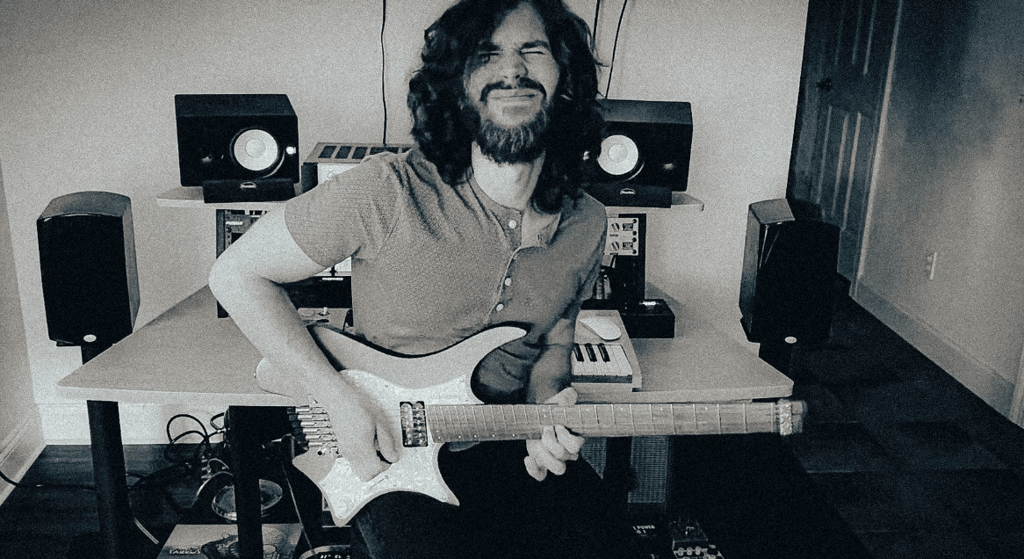We know, we know. That sounds stupid. Since you’re reading this, you are probably very aware of what the point is: to create awesome music. But that can be done with any guitar, traditional as well as headless. So, what then, is the point of a headless guitar?
In this blog article, we’ll go through:
- The sound of headless guitars
- How are headless guitars different?
- Headless guitars compared to traditional electric guitars
- Musicians playing headless guitars
We can start by looking at it from our point of view. That is, what is the point of designing and building guitars that have no head? The base principle for us has always been ergonomics.
Since our founder Ola started to design and build headless guitars (which was eons ago, some call it “the 90s”) ergonomics has been the main principle. He did not start with the idea of creating a headless guitar, he wanted to create a better guitar. And to achieve that, the head had to go.
Over the years, other ideas and design elements have made their way into our .strandberg* world, but ergonomics is still the base for our design and our instruments.
Let’s go back to the original question: if the point of a headless guitar from our perspective is ergonomics, then the point of headless guitars from the player’s POV is joy. To have the opportunity to play without pain, and to have fun for as long as possible.

Do headless guitars sound better?
Short answer? It depends. This question, like many of its kind, is dependent on personal preference and context. The headstock itself (or, the lack of it) does not have a major effect on the sound. Many parts have a bigger impact, such as the body, the pickups, and of course the hardware.
As for our guitars, the .strandberg* sound has always been warm, rich, and defined. It is broad and deep while being focused and punchy. It can be aggressively loud and growling, yet sensitive and hyper-responsive to the player’s most delicate touch.
The lows, the mids, and the highs are coherent and in harmony with each other – not emphasizing any particular range of frequencies, except for the natural sonic character of the particular woods used in the construction of the instruments.
But, that’s our sound. Not the sound of all headless guitars. Overall, the answer to the initial question is that it depends. It depends on what you consider to be “better”, and what you like. There are hundreds of headless guitars out there, and as always, the best way to find out is to try the guitar for yourself.
How to tune a headless guitar
If you haven’t used headless guitars before, tuning, string changes, and the setup process may seem a little daunting at first. But you will soon find that maintenance work on a .strandberg* guitar is quite intuitive and easy to perform once you get a hang of it.
Check out our support documentation here

How are headless guitars different?
There is a quote from Reddit that summarizes this question better than any guide, video, or article could ever do. When asked about the benefits of headless guitars, one user wrote:
“I think they’re clearly superior instruments, a modern update that solves some string issues and improves portability. But they don’t look cool so I’ll never buy one lol”
This is so good we had to include it here. It’s so good actually that we should put it on our website somewhere. First off, it encapsulates the discussion about “headless versus traditional guitars” in two sentences, and second – it’s (mostly) correct.
Headless guitars are considered “better” by some guitar players mostly because of the reduced weight, and the strandberg* guitars have been praised by guitarists because of the ergonomics. Most headless guitars are also a little smaller than traditional guitars, so they are more portable.
But most importantly this quote shows how important personal tastes and preferences are. This guitar player (obviously) knows all the benefits of headless guitars but still chooses to avoid them because of personal preference.
Headless guitars compared to traditional electric guitars
When it comes to choosing between a .strandberg* headless guitar and a traditional electric guitar, it’s important to understand the key differences. While neither option is inherently superior, these distinctions can help you decide which instrument aligns better with your preferences and playing style.
- Different Centre of Gravity
- Patented EndurNeck Profile
- Multi-Scale Design
- Reduced Weight
Different Centre of Gravity
One of the most noticeable differences between a .strandberg* headless guitar and a traditional electric guitar is their center of gravity. In headless guitars, the weight distribution tends to be more evenly spread throughout the body, making them feel well-balanced. This characteristic can contribute to reduced strain during long performances, particularly for those who appreciate a lighter, well-centered instrument.
Patented EndurNeck Profile
A unique feature of the .strandberg* headless guitar is the patented EndurNeck profile. Unlike the common round profiles found on traditional electric guitars, the EndurNeck profile offers an asymmetrical, trapezoidal, and ergonomic shape. While this can be a matter of personal preference, some players find it more comfortable and supportive, especially during extended playing sessions.
Multi-Scale Design
This is not exclusive to headless guitars, but it’s a recurring feature for the .strandberg* guitars. This design choice involves arranging the frets on a calculated angle, resulting in each string having a different scale length. While traditional electric guitars typically employ a uniform scale length across all strings, the multi-scale design can enhance string tension, intonation, and overall playability, catering to specific playing styles and tonal preferences.
Reduced weight
In addition to being headless, .strandberg* guitars are often lighter than most traditional electric guitars. This weight reduction stems not only from the absence of a headstock but also from the overall design and materials used in construction. Lighter guitars can be advantageous for musicians who prefer mobility and less strain on their shoulders and backs, particularly during lengthy performances.
In conclusion, the choice between a .strandberg* headless guitar and a traditional electric guitar ultimately depends on individual preferences and playing styles. Both options offer unique characteristics that can enhance the playing experience, but neither is inherently better than the other. Exploring these differences can help you make an informed decision that aligns with your musical aspirations and comfort.
You could also explore some of the artists who’ve chosen to go down the “headless path”.

Musicians playing headless guitars
Many guitar players choose headless guitars, among the most influential contemporary artists are Yvette Young, Plini, Tosin Abasi, and Per Nilsson. But even more traditional guitar players such as Mark Knopfler and Eddie Van Halen have played headless guitars.
There are around 40 .strandberg* artists, all with their own, unique style. Below we list four of them: Plini, Richard Nilsson, Richard Henshall, and Sara Longfield. If you want to read about all of our artists, check them out here.
Plini
One of the most promising and highly acclaimed new guitar players and composers to burst onto the crowded prog-metal and instrumental guitar music scene in a long time, Plini – hailing from Sydney, Australia – combines masterful guitar virtuosity with a highly developed sense and style of composition that has won a dedicated following all around the world.
Per Nilsson
Per Nilsson is the prototypical modern metal guitarist: virtuosic in both rhythm and lead playing, melodic yet mean, brutal while musical, and intelligent as well as instinctive as a writer. Per embodies the evolution and development of modern metal music with his work as the founding member of Scar Symmetry, the influential melodic death/progressive metal band, Kaipa, a Swedish progressive rock band, as well as his work filling in for the legendary Fredrick Thordendal of Meshuggah. Per knows metal.
Richard Henshall
Richard Henshall is acclaimed for his work as a founding member of the progressive metal juggernaut HAKEN. The band has 5 full-length albums, 1 EP, and a Live DVD in their catalog including the celebrated The Mountain (Inside Out Records, 2013), Vector (Sony/InsideOut, 2018), and their most recent offering, Virus (Inside Out Records, 2020).
Sara Longfield
One of the most exciting new guitarists in the metal genre, Sarah Longfield has attained international notoriety in metal circles with her superb 8-string technique, feel for melody and eclectic musical background to take metal to new uncharted territories.














Share this: